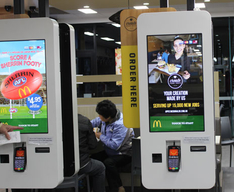Enhancing the customer experience through customization and convenience is more important than ever.
While kiosk systems have existed since the early 1990s, their presence in the restaurant industry has increased in recent years as large brands such as Panera, McDonald’s, and Wendy’s experiment with technology. This trend is driven by the significant decrease in the cost of a kiosk system and a growing need to enhance the customer experience through customization and convenience.
Dozens of emerging companies offer ordering platforms ranging from iOS compatible programs to complex hardware systems. Benefits to the customer include reduced waiting time, greater control of the ordering process, and customization.
While benefits to tech-savvy millennials are obvious, benefits to the restaurant vary and are largely dependent on size, concept, and customer demographics. In a time of fierce competition, any effort to improve the customer experience to increase market share may be worth making. Couple traffic growth with improvements in average check and operations, and the investment can surely have a positive return on investment. Here’s how:
Reduce ordering time: With a larger menu, the traditional ordering process can often lead to delays in total service time. Self-serve kiosks or mobile ordering systems help customers navigate the menu with messaging that is manageable and bite-size.
Increase order accuracy: While staff may be trained to repeat back to a customer his or her order prior to processing, order errors are still inevitable, especially with more customization options. A visual recap of a customer’s order puts the responsibility on the customer, increasing accuracy.
Reduce labor costs: In certain instances, kiosks may provide labor savings if the concept allows changes to the front-of-house structure. However, be careful in how you do this: In the case of Panera, the addition of kiosks resulted in the need of more front-of-house employees to aid in technical support.
Alter menu prices in real-time: Promote or discount items to move inventory or leverage favorable food costs to the restaurant’s bottom-line advantage. As printed menus are static and offer less flexibility, kiosk systems, depending on the vendor, offer real-time adjustments to content.
Grow checks through effective upselling: Training staff to effectively upsell multiple messages is often challenging. These digital platforms enable the restaurateur to program multiple messages based on customers’ purchase behavior. For example, upsell extra bacon for a burger or a pint of Belgium beer for the steamed mussels.
Trade customers to more profitable items: The ability to sufficiently market high-priced items may be limited given the space on a printed menu. Ordering systems have no space limitations and have more room to entice customers into more profitable items through imagery and compelling item descriptions.
While kiosks provide restaurants with an amazing platform to increase average checks by 15 to 20 percent, their effectiveness is contingent on understanding customer purchase behavior. Just like with a printed menu, customers are still inclined to order certain items over others purely based on an item’s location on the screen.
With this in mind, while it may be intuitive to suggest bacon to the burger customer, what if data suggests that the likelihood that the customer may be persuaded to purchase a milkshake is higher? By effectively managing the content and flow of information to the customer, the likelihood of that upsell increases.
Finally, with the rollout of mobile loyalty and ordering platforms, it’s important to understand how the kiosk platform can complement and enhance the experience of the mobile user. By further leveraging loyalty data, customers’ ordering experience can be further personalized, enhancing their overall experience and love and loyalty to the brand.
While it’s clear that more and more brands are investing in technology such as kiosk ordering, tablet menus, and mobile aps, full benefits from those investments start and end with data, leading to a complete understanding of what the customer wants and is willing to pay for.
Dora Furman, Vice President of Consulting Services at Revenue Management Solutions, directs the company’s work for multi-national brands in the quick service, casual, and fine-dining space. She has a Bachelor’s in Business Administration from the University of Michigan, and a Master’s in Hospitality Management from Cornell University. Prior to joining RMS, she worked as a CPA at PricewaterhouseCoopers and a financial analyst supporting the sales team at PepsiCo.
Link to article: https://www.qsrmagazine.com/outside-insights/6-key-ways-self-serve-kiosks-can-boost-your-sales


bookmarked!!, I like your blog!
Wonderful post however , I was wondering if you could write a litte more on this topic?
I’d be very thankful if you could elaborate a little bit further.
Thank you!
What additional info are you looking for?
You could certainly see your skills within the work you
write. The world hopes for more passionate writers such as you who aren’t afraid to mention how they believe.
All the time go after your heart.
I enjoy reading through your website. Thanks!
Great post.